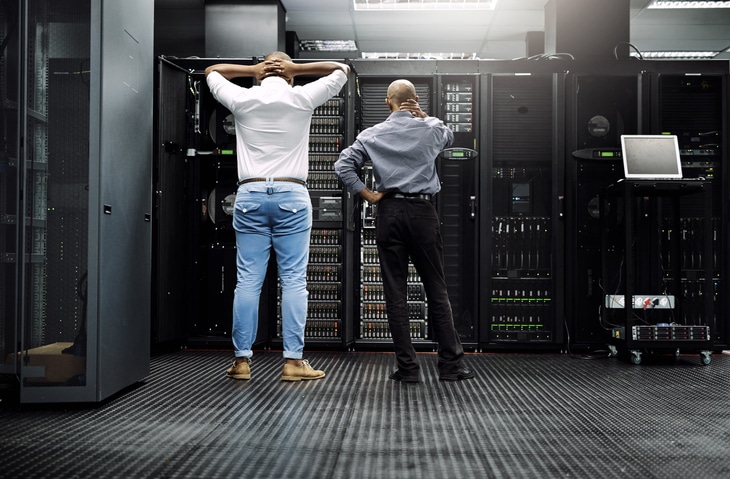As one of the leaders of an inspiring technology business filled with smart, energetic, talented people, I’m immersed in innovation on a daily basis. But every once and a while something causes me to pause and think about the breathtaking rate of technology change and seemingly endless diversification that continues to amaze us.
Recently, that reminder came out of a casual conversation with a colleague when it dawned on me that I have seemingly overnight become an ultimate consumer of the cloud. It was not long ago that I was dependent on software deployments to be productive at work, but now majority of applications I use at Red8 are accessed through the cloud. And while I still love to browse a good bookstore, I obtain all my reading material and music through cloud-based products and services. It was just a small reminder that change is happening before our eyes.
Cyber security, artificial intelligence, machine learning and virtualization are just a few examples that have us in the corporate world feeling collectively dizzy with the possibilities. But with any new advancement comes challenges. And while technology’s mission is to ultimately make things easier for us, we all know that there is no getting around it. Change is hard.
Thanks to the dynamic market and continuing influx of innovation, the majority of IT leaders will fall into one of two general camps.
The first represents the professionals leading more seasoned and established organizations. They will need to be laser focused on keeping a vigilant eye on new technology advancements while remaining dedicated to serving the business’ needs and protecting its data – all without additional cost or single disruption to the business. This is no small feat. Because change in today’s IT environment is not optional. And any change has the potential put the business at risk.
Take for example, the cloud. Forrester Research predicts that in 2017, beyond pay-per-use, buyers will save money in the cloud in many ways. While end users and consumers are jumping quickly into the cloud, many IT leaders have been rightfully slower in moving corporate infrastructure to the cloud because, while the benefits are real, they also see the ripple effects it has on areas such as security that will be left exposed.
So the questions quickly become, how best to determine the path that is most productive yet secure, and at the same time, cost effective? How can these mostly larger organizations operate more like startups that have virtually nothing to lose and everything to gain, when they are already deep and complex?
The second camp will approach cutting edge innovation in a more proactive manner, taking on as much new technology as possible in order to create differentiators that will accelerate the business. Typically, this scenario describes smaller and medium sized organizations, as they are inherently less encumbered by history and free to embrace new technology faster. They may use IT to drive costs out of the supply chain or consider automation as a means to get bigger, faster on limited resources. They may migrate to the cloud partially or fully and focus on using data and analytics to engage customers in a new way and sell more product. And while change is clearly easier to embrace when your business is still young and agile, determining how and where to apply today’s vast enterprise technology options still requires experience, strategy and support.
But whether you are an established industry leader trying to embody some of the attractive attributes of the upstarts, or an aspiring tech unicorn seeking to become the new standard, two things in 2017 will remain constant. Businesses all want to do more with less and they will all integrate changing technology into the organization.
How do we accomplish this? Together. We at Red8 work with organizations of all sizes and stages and provide great value from our vast industry experience with both new and legacy technology. We live and breathe your challenges and understand the potential. So, in the midst of this very exciting time, let’s create a map to the future together that is paved with growth and prosperity, and fueled by inspiration and integrity.
Recently, that reminder came out of a casual conversation with a colleague when it dawned on me that I have seemingly overnight become an ultimate consumer of the cloud. It was not long ago that I was dependent on software deployments to be productive at work, but now majority of applications I use at Red8 are accessed through the cloud. And while I still love to browse a good bookstore, I obtain all my reading material and music through cloud-based products and services. It was just a small reminder that change is happening before our eyes.
Cyber security, artificial intelligence, machine learning and virtualization are just a few examples that have us in the corporate world feeling collectively dizzy with the possibilities. But with any new advancement comes challenges. And while technology’s mission is to ultimately make things easier for us, we all know that there is no getting around it. Change is hard.
Thanks to the dynamic market and continuing influx of innovation, the majority of IT leaders will fall into one of two general camps.
The first represents the professionals leading more seasoned and established organizations. They will need to be laser focused on keeping a vigilant eye on new technology advancements while remaining dedicated to serving the business’ needs and protecting its data – all without additional cost or single disruption to the business. This is no small feat. Because change in today’s IT environment is not optional. And any change has the potential put the business at risk.
Take for example, the cloud. Forrester Research predicts that in 2017, beyond pay-per-use, buyers will save money in the cloud in many ways. While end users and consumers are jumping quickly into the cloud, many IT leaders have been rightfully slower in moving corporate infrastructure to the cloud because, while the benefits are real, they also see the ripple effects it has on areas such as security that will be left exposed.
So the questions quickly become, how best to determine the path that is most productive yet secure, and at the same time, cost effective? How can these mostly larger organizations operate more like startups that have virtually nothing to lose and everything to gain, when they are already deep and complex?
The second camp will approach cutting edge innovation in a more proactive manner, taking on as much new technology as possible in order to create differentiators that will accelerate the business. Typically, this scenario describes smaller and medium sized organizations, as they are inherently less encumbered by history and free to embrace new technology faster. They may use IT to drive costs out of the supply chain or consider automation as a means to get bigger, faster on limited resources. They may migrate to the cloud partially or fully and focus on using data and analytics to engage customers in a new way and sell more product. And while change is clearly easier to embrace when your business is still young and agile, determining how and where to apply today’s vast enterprise technology options still requires experience, strategy and support.
But whether you are an established industry leader trying to embody some of the attractive attributes of the upstarts, or an aspiring tech unicorn seeking to become the new standard, two things in 2017 will remain constant. Businesses all want to do more with less and they will all integrate changing technology into the organization.
How do we accomplish this? Together. We at Red8 work with organizations of all sizes and stages and provide great value from our vast industry experience with both new and legacy technology. We live and breathe your challenges and understand the potential. So, in the midst of this very exciting time, let’s create a map to the future together that is paved with growth and prosperity, and fueled by inspiration and integrity.

